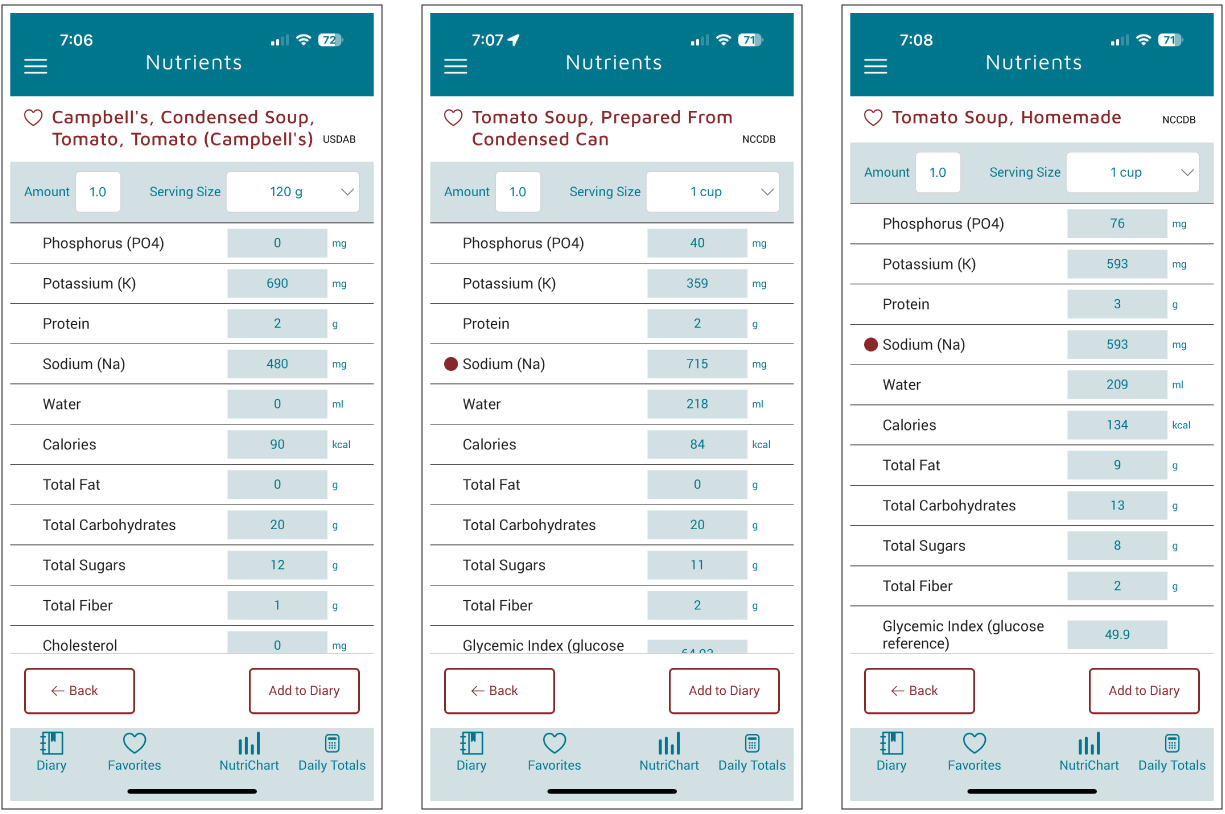Need Help With Our App?
Tips for Getting the Most Out of KidneyDiet
1. Consult a dietitian when you have questions about how to eat right for your particular health concerns.
You should always consult with a dietitian when you have questions about how to eat right for your particular health concerns. It’s a good idea to work with your dietitian to determine guidelines for your intake of nutrients.
To set these guidelines within KidneyDiet, please follow the steps here.
2. Educate yourself about which foods are better for you than others. Set the guidelines for your health concerns within KidneyDiet.
Educate yourself about which foods are better for you than others. That way you can make an informed decision before you start searching for foods. But, even if you aren’t sure, you will start to learn more about each food as you start searching our database and learning about nutrients within foods.
3. Set the guidelines for your health concerns within KidneyDiet.
Set the guidelines for your health concerns within KidneyDiet.
To set these guidelines within KidneyDiet, please follow the steps here.
4. Type in the search bar when you look for foods.
Type in the search bar when you look for foods to add to your Daily Diary. When you type here, try to use generic and descriptive terms. For instance, if you look up “pineapple” rather than “Dole pineapple”, you will get important information that may not be on a label on the outside of a can. When watching certain nutrients if you have chronic kidney disease, you may find that labels are often missing how much water and phosphorus, among other things, are missing from labels. KidneyDiet does provide correct nutrient counts if you search more generically for your item. This is why scanning barcodes does NOT give you the best data. For more information visit our blog post here.
5. Turn off the USDAB. Don’t scan barcodes.
You can do this by going into the FlyOut Menu in the top left corner of the app by selecting the 3 horizontal bars. Then go to Settings and TURN IT OFF. Yes, this will make it impossible to use the barcode scanner. That will in turn provide you with the best data for similarly named foods which will be more easily found by common, generic, names. That means you should type in the search bar and don’t use brand names. The items may not match exactly but the counts will give you a pretty close estimate to what packaged food labels present. For more information visit our tutorial here.
6. Don’t create custom foods that are already in the database.
Don’t create Custom Foods that are already in the database unless your dietitian has directed you to do so. KidneyDiet has hundreds of thousands of foods in the database and these have a more comprehensive set of nutrients available than what you are likely to find on the web or listed on food products, unless you are getting your data directly from a dietitian.
General Questions
1. What’s the best way to search for a food?
The best way to search within KidneyDiet is to select the “+” sign and then type in the search bar. Searching in this manner, rather than scanning bar codes, will provide you with our most comprehensive, research-grade data.
You can use food names with descriptions, and you can sometimes even use a brand name in the search field. But, if you don’t get the results you’d like, you may want to be less limiting by omitting the brand name and some of the descriptors. Oftentimes, getting close to the item you want will still provide really good data that can help you even if the name of the item isn’t exact.
Try this example: Look up Campbell’s Tomato Soup. View the sodium and water content. Now, lookup “tomato soup” and select the option with “condensed” in the title to try to match the canned soup you first found. Notice the difference in water and phosphorus. As a third part to this, try looking up “homemade tomato soup” and view the differences listed here in the nutrients.

2. Why do I keep getting messages saying that foods are higher in nutrients than shown?
When you get lots of messages popping up saying that foods are higher in nutrients than shown, or you see a list of nutrients full of a red yield warning sign, that means you are relying on data from food manufacturers. Packaged foods are only required to list some nutrients on the label. Oftentimes, food manufacturers (that is, any branded, packaged items) do not list all nutrients. That means that phosphorus and water will not be shown. That does not mean the item does not contain those nutrients. It only means the USDA and FDA do not require that it be made available to the public. If you don’t scan a barcode, or if you don’t limit your search with brand names, you will most likely see the KidneyDiet search results show fully comprehensive nutrients. Try this by typing in “pineapple” or Dole Pineapple Chunks”.
3. How Do I Create a Meal?
You can now create a meal by adding multiple foods into a group and naming it. For instance, perhaps you always have the same breakfast and you want to make it easy to add this to your Daily Diary.>Follow these steps to create your breakfast: select the + sign to add a food. Then search for “scrambled eggs”. Add 2 eggs to your diary. Add a dash of salt. Add two pieces of toast. Add 1/2 cup of berries. Name this: Breakfast w Scrambled Eggs. Now you will be able to find this in your list of Meals. Or you can search for it. See Create a Meal By Steps for more information here.
4. Why do you give us a barcode scanner and then tell us not to use it?
A barcode scanner allows you to easily find a food and it will present you with some of the nutrients in that food. For instance, if you are interested in watching fat, calories and sodium, then the barcode scanner is a great tool for you! But if you need to watch phosphorus or water or the glycemic index or glycemic load of foods, you won’t find that information from a food label which is what the barcode scanner is basically showing you. So, what should you do? You should follow the steps above to turn off the USDAB and you should use generic terms typed into the search bar when seeking foods. But, if all you need to watch are calories, sugar, fat, carbohydrates, protein and sodium, then scanning barcodes will have the data you are seeking.
5. Why am I limited in creating custom foods?
You are allowed to create 20 custom foods. But, our data is likely far more comprehensive than data you will find on the web. Therefore, we suggest you use the KidneyDiet database which has hundreds of thousands of foods listed with comprehensive data. If you must create more than 20 custom foods, please reach out to us as we’d be happy to help you. Visit our contact page here.
6. Why am I limited in creating meals?
If you’ve reached your allotment of meals, please let us know. Visit our contact page here.
7. Why doesn’t the USDA and/or food manufacturers give us all the data we need?
The USDA and food manufacturers provide data that addresses the concerns of many people. These concerns change over time and are addressed in future label updates. At one time, it was important to make sure everyone got their daily intake of Vitamin C. Today you don’t hear that people are lacking in Vitamin C. However, you may see that Vitamin D is now listed on labels as that is a concern. Phosphorus, water, oxalates, glycemic load, etc.. and other nutrient information is provided by KidneyDiet to help address areas that are of concern to people with chronic kidney disease that may not currently be listed on labels.
8. What if I only care to learn and track sodium, fats, and calories?
If these are the only things of interest to you, you will benefit from using the bar code scanner. If you need more information than this, please follow the steps listed in the Tips section.
9. Why doesn’t KidneyDiet data match the data on a packaged food label?
Food manufacturers are regularly updating their labels to match changes in their packaged foods because either nutrients or serving sizes or other items have changed. KidneyDiet strives to keep the database current with these changes but sometimes there is a period of time when items are out of sync. Oftentimes, these do not present big discrepancies and items found that are very similar can be used in place of an exactly named item.




